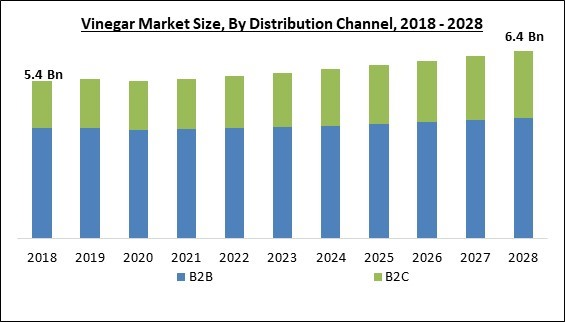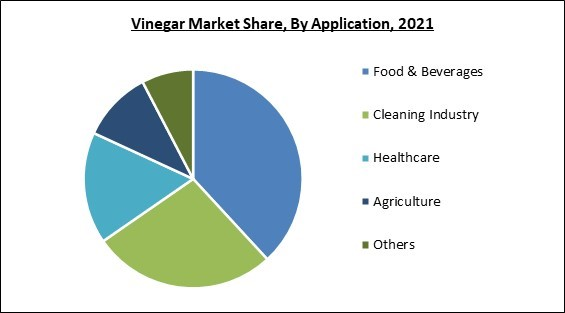The Global Vinegar Market size is expected to reach $6.4 billion by 2028, rising at a market growth of 2.5% CAGR during the forecast period.
Vinegar is an acidic liquid created when acetic acid bacteria ferment ethanol. It is utilized in cooking for both its chemical and flavor-enhancing capabilities. It may be made from several essential components, each adding its distinct qualities to the vinegar and giving the meals used more taste and brightness.
The increased consumer knowledge of vinegar's variety of uses is anticipated to drive the market for vinegar. Because it slows down some foods' natural decaying, vinegar's acid is utilized to preserve food. Most frequently, vinegar is used to make healthy recipes. Also, it lessens the quantity of fat in meals and helps maintain stable blood sugar and cholesterol levels. Because they easily dissolve caked-on dirt, grease, and grime due to their high acidity, less-priced vinegar, like distilled white wine vinegar, is suitable for cleaning, and these factors will aid the market growth.
With ethanol-containing components, including beer, wine, distilled grain alcohol, cider, champagne, and others, vinegar is an acidic liquid created by fermentation. Several bacteria cultures are used throughout manufacturing, and the finished vinegar is pasteurized to eradicate the mother culture. Vinegar is often used to balance different food items' tastes and provide tart and sour qualities to cuisine. Due to its highly acidic composition, it has a long shelf life and is resistant to early deterioration.
The mother of vinegar (MOV), a bacterial culture that may cause a slimy glob of sediment in vinegar, has been destroyed by heat treatment in pasteurized vinegar. Although the sediment is not harmful to many people, and many think that unpasteurized vinegar is healthier. The majority of vinegar varieties have been pasteurized to avoid the occurrence of sediment since it may be unpleasant to customers. Pasteurization, which prevents germs from growing, also helps maintain product uniformity and stability. Raw vinegar is often labeled when it has yet to be processed.
The market research report covers the analysis of key stake holders of the market. Key companies profiled in the report include The Kraft Heinz Company, Carl Kühne KG (GmbH & Co.), Mizkan Holdings Co., Ltd., Eden Foods, Inc., De Nigris Group, Australian Vinegar, Burg Groep B.V., Marukan Vinegar (U.S.A) Inc. (Marukan Vinegar Co., Ltd.), Molson Coors Beverage Company (Aspall Cyder Ltd.) and White House Foods.
Vinegar is an acidic liquid created when acetic acid bacteria ferment ethanol. It is utilized in cooking for both its chemical and flavor-enhancing capabilities. It may be made from several essential components, each adding its distinct qualities to the vinegar and giving the meals used more taste and brightness.
The increased consumer knowledge of vinegar's variety of uses is anticipated to drive the market for vinegar. Because it slows down some foods' natural decaying, vinegar's acid is utilized to preserve food. Most frequently, vinegar is used to make healthy recipes. Also, it lessens the quantity of fat in meals and helps maintain stable blood sugar and cholesterol levels. Because they easily dissolve caked-on dirt, grease, and grime due to their high acidity, less-priced vinegar, like distilled white wine vinegar, is suitable for cleaning, and these factors will aid the market growth.
With ethanol-containing components, including beer, wine, distilled grain alcohol, cider, champagne, and others, vinegar is an acidic liquid created by fermentation. Several bacteria cultures are used throughout manufacturing, and the finished vinegar is pasteurized to eradicate the mother culture. Vinegar is often used to balance different food items' tastes and provide tart and sour qualities to cuisine. Due to its highly acidic composition, it has a long shelf life and is resistant to early deterioration.
The mother of vinegar (MOV), a bacterial culture that may cause a slimy glob of sediment in vinegar, has been destroyed by heat treatment in pasteurized vinegar. Although the sediment is not harmful to many people, and many think that unpasteurized vinegar is healthier. The majority of vinegar varieties have been pasteurized to avoid the occurrence of sediment since it may be unpleasant to customers. Pasteurization, which prevents germs from growing, also helps maintain product uniformity and stability. Raw vinegar is often labeled when it has yet to be processed.
COVID-19 Impact Analysis
COVID-19 affected various industrial businesses since it caused workplace closures, supply chain disruptions, and transit limitations. Several nations implemented the lockdown in this situation, which caused production and industrial facilities to stop operating. Since the pandemic, the bread, liquor, and dairy businesses, as well as the food service industry, have seen a decline in sales, negatively impacting the market. In addition, the lockdown during this period negatively impacted the supply chains of various industrial facilities and several utilities, which caused a significant decline in sales and earnings. Yet, a large increase in imports and export is anticipated due to the ongoing relaxations.Market Growth Factors
Applications in numerous industries
In many home cuisine recipes, vinegar is a common ingredient. It is used for baking and works well as a preservative to keep food fresher for longer, particularly pickles. Acetic acid is a sour ingredient that may be used to sauce, vinegar, pickled vegetables, and as a raw material for spices. Vinegar is often used as a preservative, seasoning, and dressing in culinary products. It is also gaining acceptance as a home treatment for various medical conditions. Moreover, apple cider vinegar increases immunity and metabolism, aids in weight reduction, and does other things. Several nutraceutical makers are introducing Apple cider vinegar as a health beverage and supplement, promoting the industry's expansion.Various health advantages
Vinegar has been used as a home treatment to cure gastroesophageal reflux disease or GERD. Consuming vinegar may boost stomach acid and enhance digestion if a condition with low stomach acid brings GERD. According to a different notion, vinegar may aid in lowering blood pH to create a more acidic environment that obliterates dangerous microorganisms in the stomach. The treatment of various diseases with the help of vinegar will increase its consumption and thereby boost the market growth in the projected period.Market Restraining Factor
Contamination of raw material and lack of regulations
The absence of regulations for standardization, a lack of knowledge about the advantages in developing nations, and changes in the demand-supply spectra due to tighter restrictions in many regions would make the market scenario even worse. The market expansion may be hampered by the government's strict rules, the expensive nature of the product, and the widespread availability of alternatives. Also, the lack of government regulations in many nations and contamination issues will hinder market expansion.Product Outlook
Based on product, the vinegar market is segmented into balsamic, red wine, cider, white, rice and others. The red wine vinegar segment procured a promising growth rate in the vinegar market in 2021. This is because vinegar made from red wine may aid in weight loss. Acetic acid-upregulated fatty acid oxidation is thought to cause this impact. Red wine vinegar has anti-microbial qualities, which is another benefit. Red wine vinegar contains beneficial elements, including iron, potassium, and several essential vitamins and minerals.Source Outlook
On the basis of source, the vinegar market is divided into organic and synthetic. The synthetic segment garnered a substantial revenue share in the vinegar market in 2021. This is because chemical techniques are used to create synthetic vinegar, such as the oxidation of acetaldehyde from natural gas or petroleum derivatives to acetic acid. Usually, vinegar is made using this method for industrial or commercial uses. It has additives or preservatives to enhance its taste, color, or shelf life. Non-organic agricultural methods improve crop output while defending it against pests and disease.Application Outlook
Based on the application, the vinegar market is bifurcated into food & beverages, healthcare industry, cleaning industry, agriculture industry and others. The cleaning industry segment acquired a significant revenue share in the vinegar market in 2021. This is owing to the fact that vinegar is acidic; it works well as a disinfectant and cleanser in the cleaning sector. Vinegar's acetic acid aids in the dissolution of dirt, grime, and mineral deposits from surfaces, making it a powerful natural cleaner for many surfaces, including glass, floors, counters, and more. Vinegar is a natural disinfectant since it also kills germs and viruses.Distribution Channel Outlook
On the basis of distribution channel, the vinegar market is classified into B2B and B2C. The B2B segment generated the highest revenue share in the vinegar market in 2021. This is because for producers to reach companies that utilize vinegar products in their operations, B2B sales channels are crucial. Businesses may access a greater variety of vinegar products due to the B2B channel, which offers a productive method of product distribution. The demand for specialty vinegar in the B2B sales channel is rising as customers show a great interest in unique and artisanal culinary items.Regional Outlook
Region-wise, the vinegar market is analyzed across North America, Europe, Asia Pacific, and LAMEA. The North America region witnessed the largest revenue share in the vinegar market in 2021. The growth is owing to the growing need for diverse dietary options. Also, customers favor manufacturing sauces, dressings, and condiments made with organic components. In addition, consumer worries about their health have increased the need for low-sodium and more protein-rich sauces in the area, leading to increased demand for salt substitutes and boosting the market's expansion in the region.The market research report covers the analysis of key stake holders of the market. Key companies profiled in the report include The Kraft Heinz Company, Carl Kühne KG (GmbH & Co.), Mizkan Holdings Co., Ltd., Eden Foods, Inc., De Nigris Group, Australian Vinegar, Burg Groep B.V., Marukan Vinegar (U.S.A) Inc. (Marukan Vinegar Co., Ltd.), Molson Coors Beverage Company (Aspall Cyder Ltd.) and White House Foods.
Scope of the Study
By Distribution Channel
- B2B
- B2C
- Specialty Stores
- Supermarkets & Hypermarkets
- Convenience Stores
- Online
- Others
By Application
- Food & Beverages
- Cleaning Industry
- Healthcare
- Agriculture
- Others
By Source
- Organic
- Synthetic
By Product
- Balsamic
- Red Wine
- Cider
- White
- Rice
- Others
By Geography
- North America
- US
- Canada
- Mexico
- Rest of North America
- Europe
- Germany
- UK
- France
- Russia
- Spain
- Italy
- Rest of Europe
- Asia Pacific
- China
- Japan
- India
- South Korea
- Singapore
- Malaysia
- Rest of Asia Pacific
- LAMEA
- Brazil
- Argentina
- UAE
- Saudi Arabia
- South Africa
- Nigeria
- Rest of LAMEA
Key Market Players
List of Companies Profiled in the Report:
- The Kraft Heinz Company
- Carl Kühne KG (GmbH & Co.)
- Mizkan Holdings Co., Ltd.
- Eden Foods, Inc.
- De Nigris Group
- Australian Vinegar
- Burg Groep B.V.
- Marukan Vinegar (U.S.A) Inc. (Marukan Vinegar Co., Ltd.)
- Molson Coors Beverage Company (Aspall Cyder Ltd.)
- White House Foods
Unique Offerings
- Exhaustive coverage
- The highest number of market tables and figures
- Subscription-based model available
- Guaranteed best price
- Assured post sales research support with 10% customization free
Table of Contents
Chapter 1. Market Scope & Methodology
Chapter 2. Market Overview
Chapter 3. Global Vinegar Market by Distribution Channel
Chapter 4. Global Vinegar Market by Application
Chapter 5. Global Vinegar Market by Source
Chapter 6. Global Vinegar Market by Product
Chapter 7. Global Vinegar Market by Region
Chapter 8. Company Profiles
Companies Mentioned
- The Kraft Heinz Company
- Carl Kühne KG (GmbH & Co.)
- Mizkan Holdings Co., Ltd.
- Eden Foods, Inc.
- De Nigris Group
- Australian Vinegar
- Burg Groep B.V.
- Marukan Vinegar (U.S.A) Inc. (Marukan Vinegar Co., Ltd.)
- Molson Coors Beverage Company (Aspall Cyder Ltd.)
- White House Foods










